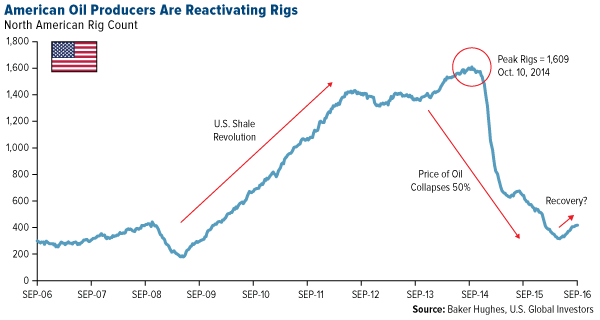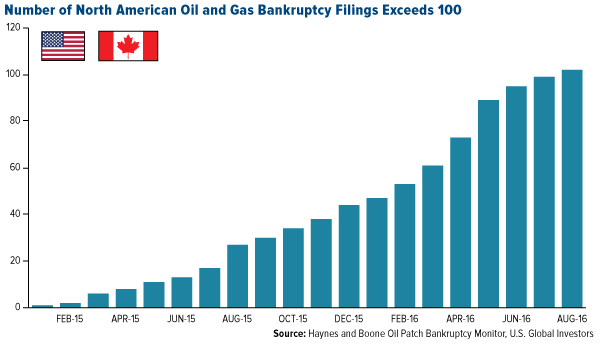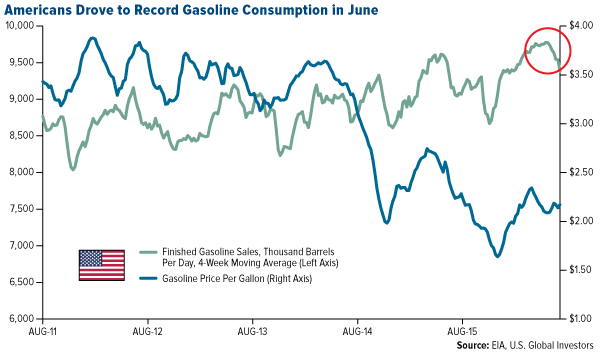Did OPEC Just Cry Uncle?
OPEC Decision Helps Oil Post Its Second Straight Month of Gains
You’ve probably heard by now that, in an effort to lift oil prices, the Organization of Petroleum Exporting Countries (OPEC) tentatively agreed to a production cut at its meeting in Algiers last week. The cartel, which controls more than a third of world output, plans to limit daily production to between 32.5 million barrels and 33 million barrels, down from 33.2 million barrels.

This comes more than two years since oil prices were kneecapped, wreaking havoc on several OPEC member nations’ economies. Saudi Arabia currently faces a steep budget deficit, as oil revenues make up close to 90 percent of the country’s budget. Meanwhile, Venezuela’s currency, the bolivar, has become so worthless that it’s now cheaper to use it as a napkin than to buy actual napkins. Airlines flying to the U.S. won’t even accept bolivars. (Of course, this has more to do with the government’s woeful mismanagement of the country than oil prices.)
It’s important for investors not to get too excited over OPEC’s decision. At the moment, none of this is set in stone. Some OPEC members are already wavering, with Iraq questioning output numbers and Nigeria moving to boost production.
Plus, American producers are likely to step into the void OPEC would create. Compared to last year, production is down only 535,000 barrels a day—and that’s with far fewer operating rigs. But it appears companies are eager to get back to work. In 12 of the last 13 weeks, North American drillers reactivated mothballed rigs. I expect to see the pace rise as it becomes clearer OPEC will make good on its resolution.

Consolidation Could Ease the Pain
For the past two years, OPEC’s pump-at-will policies have flooded the market with cheap supply, causing economic pain for producers with higher cash costs, including those involved in fracking, the Canadian oil sands and deepwater drilling.
Since January 2015, more than 100 U.S. and Canadian producers have declared bankruptcy, representing a combined $67 billion in debt, according to Dallas law firm Haynes and Boone.

To weather the low-price environment, global exploration spending has been slashed for two consecutive years. As Bloomberg reports, total investment in world oilfields stands at $450 billion, a significant 24 percent decline from last year. The International Energy Agency (IEA) expects the cost-cutting to extend into next year.
This has driven new oil discoveries to their lowest point since 1947.
It also underscores the need for industry consolidation. With exploration budgets down, major oil companies will rely on acquisitions to replace up to half of their reserves, according to energy consultancy firm Wood Mackenzie. When the airline industry was mired in bankruptcies a decade ago, we saw a huge wave of mergers and acquisitions, and we should expect to see the same in the oil patch.
A few big oil and gas deals have come out of the price rout—Royal Dutch Shell’s acquisition of BG, worth $70 billion, is the largest by far—but more will likely take place in the near term. Antitrust officials prevented energy giants Halliburton and Baker Hughes from realizing their $35 billion deal, announced back in November 2014.
America’s Gas Binge Hits a New Record
Oil inventories might be brimming all over the globe, but demand remains strong and expected to swell alongside the global middle class. As I told you in June, India is expected to have the fastest-growing demand for crude between now and 2040, replacing China.
But don’t count the U.S. out. Even with fuel efficiency improving in automobiles, Americans burned through a massive 406 million gallons a day in June, the most recent month of data from the U.S. Energy Information Administration. This sets a new record, beating the previous one set in July 2007, soon before the recession. The record might be short-lived, however, once the July and August data are released.

Low prices have emboldened many Americans to purchase vehicles with lower fuel efficiency such as trucks, vans and SUVs, which has been great for auto companies and lenders.
People are also taking longer road trips. According to the Transportation Department, motorists logged 287.5 billion miles in July, the most ever for the busy summer travel month. That’s the equivalent of taking 3,000 round trips to the sun, which is what it feels like after all the flights I’ve taken recently.
All opinions expressed and data provided are subject to change without notice. Some of these opinions may not be appropriate to every investor. By clicking the link(s) ...
more



Thanks for sharing